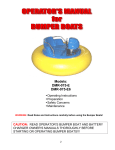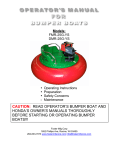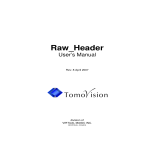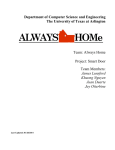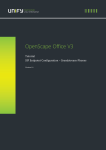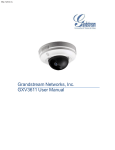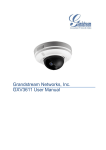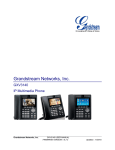Download Operators Manual
Transcript
Models: FMR-4G-P DMR-4G-P Operating Instructions Preparation Safety Concerns Maintenance CAUTION: READ OPERATOR’S BUMPER BOAT AND HONDA’S OWNER’S MANUALS THOROUGHLY BEFORE STARTING OR OPERATING BUMPER BOATS!!! 2 PREFACE Ride Safety Limitations Hazardous Environmental Conditions Emergency Shut Down Procedure Pool Requirements Operation and Service Manual 3 IMPORTANT RIDE LIMITATIONS Height Restrictions: Operator: 48” Minimum Passenger(s): 32” Minimum Number Of Boat Occupants Per Boat: Standard Multiple Rider: (1) Operator (1) Passenger Deluxe Series Multiple Rider: (1) Operator (2) Passengers Weight Restriction/ Total Rider Capacity: 300 Lbs. Maximum Operator/ Passenger Seating: Operator: Feet on floor and back to the seat. No sitting on edge of the seat. Passenger Seating: In defined seat area Back to the seat Never on the Operator’s Lap Never between Operator’s Legs Never on Operator’s Leg 4 HAZARDOUS ENVIROMENTAL CONDITIONS THAT MANDATE THE SHUT DOWN OF THE BUMPER BOAT RIDE AND ACTIVITY Electrical Storms: Never operate Bumper Boats when Lightning is present or strong potential of developing soon. An unprotected electrical source is near the pool. All electrical must be protected by proper G.F.I. devices. Flammables or Explosives are present or near the pool. Engines are leaking or spilling gasoline or oil into the pool. Clarity of the water is obscured or cloudy. Must be able to see the bottom of the pool at all times. Unsafe Water Conditions are present. Too much chemicals have been added to the water. (Excessive Chlorine) Polluted water (Bacteria Concerns) present in the pool causing unsafe conditions. Water has been subjected to gas or oil spillage. 5 EMERGENCY PROCEDURE FOR SHUTDOWN FOR ALL BUMPER BOATS WITH GASOLINE ENGINES Ride Attendants Must Be Familiar with location and functioning of the “Emergency Kill Switch”. Procedure to shutdown a running engine. (A) Release the spring loaded throttle allowing the R.P.M.’s to drop. (B) Depress and Hold the Engine Kill Switch allowing the engine to shut down. (C) After engines are shut down and boats are secured to the dock, riders must be instructed and helped to leave the boat area immediately. 6 Models: DMR-4G-P FMR-4G-P -POOL REQUIREMENTSPool Sidewall 48” Water Depth 36” 7 PREPARATION PROCEDURE FOR BUMPER BOATS WITH HONDA POWERED PROP/JETS IMPORTANT: Review the engine manufacture’s operation manual completely before using this amusement device. Make certain the engine has been properly serviced according to manufacture’s procedure before starting. Note: Engine “break-in” period is required, refer to engine’s manual. Step 1: Inflating Bumper Boat Tube The floatation tube is made of very durable and tuff PVC material. Because of the heavy wall thickness and material hardness, minimum air pressure is required. The tube should be inflated so that it feels firm to the touch. Never inflate the tube so that it feels “rock hard”. If a low range pressure gauge is available, it should be used to determine when the tube has been inflated to 2 ½ 3 psi. NEVER INFLATE TO MORE THAN 3 psi AT ANY ONE TIME!!! Note: The nature of vinyl is to stretch to some degree based on the ambient temperature. After the initial inflating of the tube and the initial stretch, the air pressure will probably drop-off to 2 – 2 ½ psi which is fine for operating the bumper boats. Note: When first inflating the tube it should be laid out without any folds. It is important when the air nozzle is being applied that the valve is not twisted and that there is some separation between the wall thickness of the tube. Separating the wall thicknesses will allow the air to go into the tube and not be stopped inside by the opposite side of the tube. Note: There are variables when operating “Bumper Boats” that might have you consider Step 1A. The variables are: (A) If your typical riders are smaller and lighter weight; (B) If your intent is to operate at fast speeds; and/or, (C) If your operating range in the pool is a great distance, then proceed to Step 1A. Step 1A: Recheck Tube Air Pressure After the initial inflating of the tube to 3 psi, wait about two hours and re-inflate the tube to 3 psi once again. If the ambient temperature is above 70oF the tube will stretch giving additional floatation to the boats. The additional size of the tube will prevent the boat from plowing when any of the three outlined conditions are present. 8 Step 2: Assembly of Fiberglass Boat to the Tube The insertion of the boat body into the center of the PVC tube will be a tight fit (especially the first few times). The fit is designed to be tight because of the nature of vinyl to stretch somewhat after initial use. Lay the floatation tube on a flat surface with the valve stem facing up. Squirt a soapy water mixture around and inside of the tube and around the bottom of the fiberglass boat. Position the boat in the center of the tube and apply equal pressure on both sides of the boat (requires a minimum of two people) at the same time, forcing the boat down into the tube. Note: The straighter the boat is pushed into the tube, the easier it will be to accomplish this procedure. The boat should be settled into the tube until the rim rests against the tube. Step 3: Installing the Prop/Jet in the Boat It is best to put the tube with the boat body into the water prior to installing the Prop/Jet assembly. Remove (4) 3/8”-16” wing nuts at the mounting hole in the floor of the boat. (Leave the (4) 3/8” split lockwashers on the mounting studs.) While lowering the lower unit of the Prop/Jet through the hole in the floor of the boat, align the (4) holes in the mounting bracket to the studs in the floor. Once in position, secure the bracket to the studs using the (4) 3/8"-16” wing nuts that were removed. Note: The proper position of the mounting bracket will have the rope tie facing out over the front of the boat. Step 3A: Retrofitting the Prop/Jet to Older Foster Boats If the Prop/Jet is to be used in an older style Foster boat (prior to 1995), it will be necessary to increase the size of the cutout in the floor of the boat. Do this by trimming the fiberglass adequately to allow the lower unit to pass through the opening and permit for swiveling of the engine. Cutout templates are available from Foster Manufacturing. Once the engine is secured to the boat, swivel the engine left and right. If complete movement is not possible, it will be necessary to trim the opening in the bottom of the boat enough to allow for the swivel of the engine without rubbing on the exhaust guard tube. 9 Step 4: Familiarization of the Honda Engine CAUTION: Refer to the Honda Owner’s Manual on the engine for proper preparation procedure and safe operating concerns before starting the engine. Points of Concern Use unleaded gasoline with a pump octane rating of 86 or higher. Never use stale or contaminated gasoline or an oil/gasoline mixture. Fresh gasoline should always have a fuel stabilizer added as soon as the gasoline is received. Use a quality, 4 stroke automotive detergent oil with a listing in either the SF or SG category. Note: Oil viscosity should be based on the typical ambient temperature range in which the engines will be operated. Note: Gasoline containing alcohol has a tendency to absorb moisture from the air. Never use gasoline with more than 10% ethanol or 5% methanol. Step 5: Servicing the Honda GXV-120 Engine After the Owner’s Manual has been thoroughly reviewed the engine should be serviced with proper oil for the crankcase and proper gasoline for the large auxiliary fuel tank. Note: DO NOT FILL THE STOCK HONDA FUEL TANK. The stock fuel tank has been disconnected from the fuel line and capped. REPEAT!!! DO NOT FILL THE STOCK FUEL TANK, only use the large auxiliary Foster tank. Note: Even though the small Honda stock fuel tank is not being used, it must remain in place. The stock fuel tank adds to proper airflow for cooling purposes. Removal of the tank will more than likely cause engines to overheat and cause premature engine failures. CAUTION: NEVER, REPEAT, NEVER, refuel the engine when it is “Hot”. Always wait until it has cooled adequately before refueling. Potential of a FIRE or an EXPLOSION is possible when refueling a “Hot” engine. CAUTION: DO NOT OVERFILL the large fuel tank. The “Full Fuel” level should allow at least 2” of space above the gasoline to the top of the tank. Step 6: Providing Gas to the Engine Open gas tank fuel valve (located at the bottom of the backside of the large fuel tank). Also, verify that the gas line fuel valve lever is to the open position (located at the carburetor). 10 Step 7: Starting the Engine For the initial start up, the throttle assembly (handle trigger) should be pulled all the way back and held for the first three or four pulls. If the engine fires, but kills out, release the throttle and pull the recoil again. Normally the three or four pulls with the throttle at “Fast Speed” will be adequate “Prime” to start the engine. (Bumper boats are normally used at high enough ambient temperatures that a manual choke is not necessary.) Release the throttle and continue to pull the recoil starter until the engine starts. If the engine does not start after an additional three or four pulls, wait a short period of time (10-15 seconds) and repeat the procedure. Sometimes it might be necessary to repeat the procedure in order to fill the gas line and prime the carburetor for initial start up. Note: For cold starts in lower ambient range it might be necessary to manually close the choke. Step 8: Consult Owner’s Manual for Proper Break-in Procedure and Duration Points of Concern: Be sure to lubricate swivel bracket assembly before using the boats. Use a good “Water Resistant Grease”. Rotate the engine at various intervals while adding grease to the swivel assembly. The initial break-in period is important to follow. Proper procedure can add longevity to the engine as well as helping to prevent premature engine failure. It is important that the engines are not run at “full speed” until they have been loosened up first. Use water-resistant grease or a silicone lubricant to periodically lubricate the throttle cable and throttle slide assembly on the carburetor to assure smooth travel. Be certain to always have all guards in place and never operate the engines without having complete engine shrouds in place. Routinely check all fasteners. Tighten if necessary. When removing fasteners be sure to reinstall with a thread adhesive “Loctite”. Routinely check wear characteristics of all bearings and bushings. Replace when excessive wear is present causing loose fits and excessive movement. 11 MAINTENANCE PROCEDURE AND CONCERNS FOR PROP/JET Maintaining the Honda GXV-120 The Model GXV-120 has been chosen for the Prop/Jet application because of its proven performance record and dependability. To assure that expected longevity and performance is received from the Honda engine, it is advisable that you familiarize yourself with the Owner’s Manual. Consult the manual for selection of gasoline and proper oil selection. Maintaining the Performance of the Prop/Jet Although the Prop/Jet is very simple in design, it requires routine inspection. The routine inspection procedure should be followed to assure good performance and minimal downtime. Reference Upper Unit Assembly 1. Inspect the throttle assembly to assure smooth functioning. Periodically, apply water-resistant grease to the cable inner wire (item #3), throttle anchor rod (item #6) and trigger rod guides (item #10). Note: Be certain that the plastic tie (item #8) is always in place to keep the throttle cable inner wire from coming out of the anchor rod. 2. Routinely check all fasteners, tighten if necessary. CAUTION: When removing fasteners be certain to re-install with a thread adhesive “Loctite”. 3. Check that the exhaust clamp (item #28) is always in place and is properly securing the exhaust pipe. Note: Never operate the Prop/Jet without having the exhaust guard pipe (item #27) properly installed to avoid risk of severe burns. 4. Routine inspection of engine shroud (item #15) that is securely fastened to the main mounting channel (item #25). Note: Never operate the Prop/Jet without the engine shroud properly installed. Without the shroud in place, there is the possibility of SEVER BURNS AND GREAT DANGER. 5. Periodically check that the gas valve (item #19) is completely open. Because of it’s concealed position under the tank it is often ignored. Sometimes when the engine is not running properly from lack of gas it is because this valve is restricting flow. Note: There are two gas fuel valves that must be maintained open. First valve is located on the Honda engine (refer to Honda’s Owner Manual). Second valve is located on the inside of the bottom side of the large auxiliary tank, back side. (To open, turn valve counter-clockwise.) 12 Reference Swivel Bracket Assembly & Steering Bushings 1. Routine inspection of the swivel bracket assembly (item #12). Inspect the socket head cap screws (item #14) making certain they are tight. 2. Routinely grease the swivel bracket to avoid premature wear on the steering bushings (items 4 and 5). Replace the bushings when they show excessive wear. Allowing excessive wear on the bushings without replacement will cause damage to the swivel bracket itself as well as damage and wear to other components. 3. Inspect drive shaft housing tube bushing (item #27) to make sure it is not rotating on the tube (item #15). This bushing should not rotate on the tube; it is intended to protect the tube from wear. Note: Bushing is held in place on the tube by both compression force by the four S.H.C.S (item #14) as well as a 5/16”-18 cup point set screw on the backside. Note: Apply water-resistant grease to the bushing (item #27) and backup thrust block (item #22). 4. Inspect steering bushings (items 4 and 5) for proper functioning. (Item #5) is intended to be held stationary to the swivel bracket (item #12). (Item #4) is intended to be held stationary to the engine mounting casting (item #32 on the Upper Unit Drawing). Wear and pivoting is done between the two bushings when properly installed. Note: Proper procedure for greasing the steering bushings is to pivot the assembly at the same time as applying grease. It is EXTREMELY IMPORTANT THAT THE ENGINE IS ROTATED WHILE APPLYING GREASE TO ASSURE PROPER DEPOSIT IN ALL LOCATIONS. Always use WATER-RESISTANT GREASE! Reference Lower Gear Case Assembly For Model FPJ-4-P 1. Periodic inspection of the gear case (item #1) is a good practice. Be certain that the end caps (items 2 and 3) are tightly in place and there is no leakage. Note: End caps are held from rotating or loosening by one cup-point set screw on each end of the gear case. CAUTION: When removing the setscrews be certain before they are reinstalled “Loctite” is applied to the threads. CAUTION: BE CAREFUL NOT TO OVERTIGHTEN SETSCREWS! Note: When removing end caps a 2” spanner wrench is required. Be careful not to cut “O” rings (item #6) or pinch them when reinstalling the caps. Note: Gear case assembly has been “serviced” at the factory with a “premium quality” S.A.E. 80w-90w gear lube. Recommended capacity is 13 ounces. 2. It is recommended that gear case lube is changed once a year. Procedure to follow is as outlined: A. Position the engine in the upright position. B. Place an adequate size container under the gear case. 13 C. The back gear case cap (item #2) will be removed to drain the gear lube. . Loosen setscrew (item #23) and using a 2” spanner wrench turn the cap counter-clockwise removing it from the case. Allow all the gear lube to drain out. D. To refill gear case position the Prop/Jet on the floor. Position the lower unit so that it is resting on the propeller guard. Now place blocking under the guard so to support the lower unit. Raise the lower unit until the drive shaft housing tube is horizontal to the floor. E. Fill the gear case with “Premium Grade” gear lube, S.A.E. 80w-90w. Allow time for the gear lube to purge through bearings. (Raise the lower unit so it is higher than the engine causing the whole bearing cavity to fill in the drive shaft tube.) Return the lower unit to a level position and refill the case to the top of the backside of the driver gear. Total volume of gear lube being used is approximately 13 ounces. F. Apply a film of grease to the “O”-Ring (item #6) on the end cap (item #2). Re-thread cap into the gear case using the 2"”panner wrench. CAUTION: Make sure that cap is completely re-installed. (Properly positioned the flat shoulder of the cap will stop at the flat shoulder of the gear case.) The end cap will be flush with the gear case. G. Completely remove set screw (item #23), apply “Loctite” and re-install. Do Not Overtighten! 3. Inspect the propeller guard assembly to make certain it is secure to the gear case. 4. Inspection of zinc anode should be done periodically (item #13). Replace the anode when signs of significant deterioration are present. Maintaining Proper Engine Speed It is important to periodically check engine’s operating R.P.M.’s in both “idle and full” speed conditions. Idle Speed 2000-2100 R.P.M.’s Full Load Speed 2900-3000 R.P.M.’s Note: Proper engine speed is very important to the Prop/Jet performance. Speed must be verified and set using a tachometer. Model FPJ-4-P Prop/Jet: Note: After break-in period it would be necessary to properly set R.P.M.’s. Note: After initial use the throttle cable might stretch causing some loss of “full-speed” R.P.M.’s. Re-tensioning the cable will be necessary. Procedure to Follow for Re-Tensioning the Cable A. Loosen the locking screw (item #6). B. While making sure that the throttle arm does not move to the fast position, stretch cable with a pair of pliers and re-tighten the locking screw (item #6). 14 TROUBLE SHOOTING Problem: Engine will not start or starts hard when cold. Possible Cause Fuel contaminants (water, dirt, etc.) in fuel line. Fuel tank gas cap restricted. Restricted fuel line or fuel shut-off valves. Low fuel level in tank. Throttle cable not properly attached. Low ambient temperature. Corrective Action Check fuel and replace if necessary. Clean or replace gas cap. Replace or clean line or shut-off valve. Fill tank to proper level. Connect and re-tension cable to proper position. Requires manually closing the choke. Problem: Engine turns over very hard when starting. Possible Cause Restriction of movement at the propeller shaft. Propeller rubbing against the guard. Failed bearings in lower unit. Damaged or mis-aligned gears. Corrective Action Remove any debris that might be wrapped around the shaft. Reposition or straighten guard for clearance. Inspect and replace defective bearings. Replace or re-position to proper location. Problem: Diminished speed or no power. Possible Cause Inadequate throttle movement. Restriction of inlet side of propeller guard. Shear pin broken. Worn or damaged propeller. Corrective Action Re-tension or replace throttle cable. Clean propeller guard screen. Replace shear pin. Replace propeller. 15 OPERATING PROCEDURE FOR BUMPER BOATS IMPORTANT: Review the engine manufacturer’s operation manual completely before using this amusement device. Make certain the engine has been properly serviced according to manufacturer’s procedure before starting. Note: Engine “break-in” period is required, refer to engine’s manual. CAUTION: All attendants involved in ride operation should be well informed and familiar with “Rules of Safe Operation,” engine characteristics and control functions of the bumper boats. All boats should go through a Daily Checklist for inspection prior to making the boats available to the customers. Record keeping is important. Step 1: The attendant should start the engine. Never allow the customers to start the engine. (Refer to starting the engine section of this manual.) Step 2: Familiarize the rider to the two basic controls. Throttle: Speed control is done using the spring loaded pull throttle grip. Throttle must be maintained. Release of the grip will cause the engine to go down to an idle speed. Stop or Kill Switch: The Honda engine is set up with a stop switch. The main purpose of the stop switch is to turn off the engine when the ride is complete or for emergency conditions. When the switch is depressed and maintained, the engine will shut down. Step 3: Loading assistance of riders should be offered to avoid accidents due to slipping or falling. Before the ride starts the riders must be seated completely and “Rules of Safe Operation: and instructions should be thoroughly reviewed with the riders. Note: If the rider(s) height is less than 12” greater than the water depth, a floatation life vest should be supplied to riders before they are allowed on the platform. Step 4: When the rider is familiar with the boat’s operational functions and “ride rules,” the engine may be started. (Refer to engine’s manual for proper starting procedure.) Step 5: Attendant should untie and release boats from the “loading platform” when the ride cycle is started. Note: For safety reasons all riders should be seated completely before any boats are released. Note: Bumper boats must be monitored at all times by ride attendant(s). 16 Step 6: When the ride cycle is complete, the rider(s) should be directed to return to available boat slips. Boats should be securely tied to “loading platform” by ride attendant(s). Note: All boats should be tied to loading platform before any rider(s) are allowed to depart. Step 7: Ride attendant should shut-off the engine and offer assistance to the departing riders to prevent the possibility of accidental slipping and falling. Step 8: Ride attendant(s) should supervise that there are orderly and safe departures of all riders that have completed their rides before allowing any loading of boats with new riders. 17 MAINTENANCE PROCEDURE FOR BUMPER BOATS Engine: Daily, routine and scheduled inspections and maintenance procedures are outlined in detail, consult the engine manufacturer’s manual. (Refer to specified manual.) Daily Inspection Required Floatation Tube: Tube should be visually inspected for cuts, leaks or potential leaks. Tubes are made of vinyl and should be cleaned frequently and a vinyl protector applied to protect the tube and keep it from getting hard. Fiberglass Boat: Visual inspection should be done that all fasteners are secure. Visual inspection as to the fiberglass structure to identify any cracks or rough surface areas that rider(s) might come into contact while in use of the boat. Mounts and Controls: Welds should be inspected (i.e.) handle bar, mounting bracket and guards. Fasteners should be checked for proper torque. Operational controls should be checked for proper functioning (i.e.) spring loaded throttle, kill switch and swivel bracket assembly. Greasing of swivel bracket. Use water resistant type grease. Note: Routinely inspect that propeller guards are in place. NEVER … NEVER OPERATE BUMPER BOATS WITHOUT PROPELLER GUARDS. 18 Pre-Opening Inspection Recorded Record for Week Ending _________ 1. 2. 3. 4. 5. 6. 7. 8. 9. 10. 11. 12. 1. 2. 3. 4. 5. 6. 7. 8. BOATS Check engine oil and fill to proper level. Inspect fuel system; check for any signs of leakage at the cap, tank, fittings or fuel line. Properly fill fuel tank after verifying there are no leakage problems. Verify complete propeller guard assembly is in place and properly secured. Inspect fasteners and fittings for looseness. Tighten properly if required. Inspect swivel bracket assembly to verify it is secure and lubricated. Inspect fastening wing nuts that secure mounting bracket to the floor of the boat. Make sure they are tight. Inspect throttle cable for smooth operation. Lubricate it if necessary. Inspect for proper assembly and integrity of all guards for safe operating conditions. Inspect Bumper Boat tube condition for proper floatation. Observe for signs of leakage. Clean engine, boat and tube to assure a clean safe ride for all customers. Start the engine and test ride the boat to verify proper operating conditions. POOL AND SURROUNDINGS Check water chemistry. Inspect for harmful water conditions. Inspect the condition of rope ties for docking boats. Verify the condition and stability of handrails. Verify that “Rules of Safe Operation” are properly positioned and visible. Check fire extinguishers and verify proper placements. Check integrity of fences and gates for proper functioning. If operating instructions and “Rules of Safe Operation” are delivered to customers via a recording, verify proper functioning and clarity. Remove all flammable materials from ride area. Sunday Monday Tuesday Wednesday Thursday Friday Note: These are basic concerns that should be addressed on a routine schedule. Each operation, depending on its own requirements should add to, but not eliminate from this checklist. 19 Saturday Rules for Safe Operation Thoroughly read and understand operator manuals before operating Bumper Boats. Never allow children or adults lacking proper instructions to operate Bumper Boats. Take precautions against fire. Fire fighting equipment should be readily accessible at the Bumper Boat activity. Handle fuel with care. Never fill the engine’s fuel tank while the engine is running or hot. Never refuel the engines when riders are in the boats or near the refueling area. Wipe clean any spilled fuel immediately. Remove unused fuel from the fueling area before starting the Bumper Boat engine. Never operate Bumper Boat engines in an enclosed area. Exhaust gasses contain carbon monoxide. The gas can be deadly when inhaled. Operating an engine at excessive speeds increases the hazard of personal injury. Do not tamper with parts, which may increase governed speed. Always remove the spark plug or spark plug wire before working on the engine. This will prevent accidental starting of the engine. Make a routine check that all nuts, bolts, screws and fittings are tight. Never operate the engine with any of the guards missing or incomplete. Never allow observers, swimmers or by-standers to be in the water while Bumper Boats are operating. Never allow multiple riders in Bumper Boats that are not designed for more than one rider. Operators of Bumper Boats should be tall enough to sit completely back in the seat with their feet on the floor of the boat. When the rider’s height is not at least 12” greater than the water’s depth, a life preserver should be provided. Never allow “Standing” or “Kneeling” in the Bumper Boats. Unusual or excessive noise should be checked immediately. Shut-off the engine an review all components. Maximum rider weight capacity is 300 pounds. No food or drinks are allowed while in the Bumper Boats. No smoking is allowed while in or around the Bumper Boats. Signs must be posted stating that riders use the Bumper Boats at their own risk. Propeller guards must always be in place when using Bumper Boats. If they are in the ride area, they must have complete guard assemblies in place. Signs should be posted cautioning persons who are pregnant or have experienced back or neck problems that they should not ride in the Bumper Boats. People with heart conditions should also not ride in Bumper Boats. Always record and keep complete records and accident reports when they involve personal injury. No matter how slight the injury seems at the time, it could be crucial at a later date. 20



















